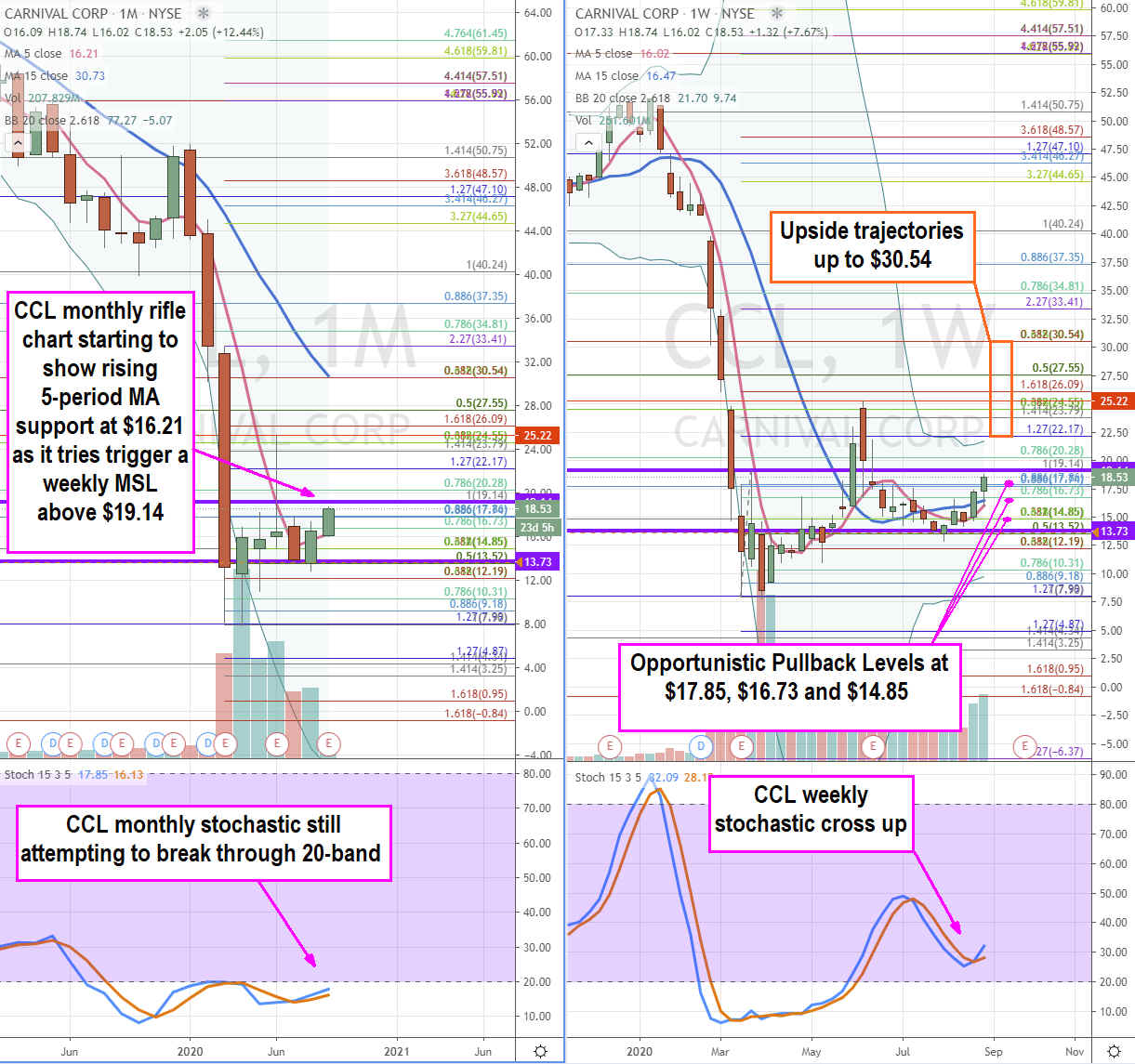Cruise ship operator
Carnival Cruise Lines NYSE: CCL shares have been punished during the global pandemic and considered an epicenter stock in an industry hurt the most by COVID-19. Images of quarantined passengers trapped out at sea during the pandemic sparked fears that the
travel and leisure industry would never recover. This PR nightmare collapsed shares throughout the travel and lodging industry. As the benchmark
S&P 500 index NYSEARCA: SPY grinds to all-time highs in a history-making rally, optimism is back as Carnival embarks on relaunching select cruises in a limited capacity. As the race for an FDA approval COVID-19 vaccine draws closer, a recovery narrative is taking shape within the industry-leading up to the binary event of a vaccine approval. Carnival shares have had many head fakes this year but may finally be setting up for a breakout with legs. Prudent investors may consider stepping into the recovery as money rotates out of momentum back into value using selective opportunistic pullbacks.
Q2 FY 2020 Earnings Release
On July 10, 2020, Carnival released its second-quarter fiscal 2020 results for the quarter ending May 2020. TheCompany reported earnings-per-share (EPS) loss of (-$3.30) versus consensus analyst estimates for a loss of (-$1.79), a (-$1.51) per share miss. Revenues fell (-84.7%) year-over-year (YoY) to $740 million beating consensus estimates of $401.4 million. The monthly cash burn is $650 million composed of $250 million for ship maintenance, $200 million of guest refunds, $115 million of capex and $85 million in interest payments. However, burn rate is expected to sequentially improve with the resumption of operations, wind down of refunds and new bookings. Carnival had $7.6 billion at the end of the quarter.
Silver Linings
The Company reduced non-essential capex by $2 million including significant cuts to marketing. New ship deliveries have been cut to five from the original nine planned in fiscal 2021. The Company doesn’t expect a return to ‘normal’ capacity levels until fiscal 2022. Carnival did provide some optimism with its fiscal 2021 bookings data indicating that full-year 2021 advance bookings remain “within historical ranges” at prices discounted to low to mid-single digits. Management noted that 45% are new customers and 55% are repeat customers. Carnival announced the sale of four ships and disposal of nine ships in 2020. This is a 9% reduction in ships from the fleet. On July 29, 2020, Carnival also announced the disposal of two more ships resulting in a Q3 2020 non-cash impairment charge between $600 million to $650 million.
U.S. Cruises Paused Until Oct. 31, 2020
Along with peer cruise lines Royal Caribbean NYSE: RCL and Norwegian Cruise Lines NYSE: NCLH , Carnival has decided to pause the resumption of U.S. cruises until Oct. 31, 2020. This exceeds the Center for Disease Control (CDC) no-sail restriction for U.S. ports through the end of September. The Companies have canceled U.S. cruises previously booked between Oct. 1 to Oct. 31, 2020. On Aug. 25, Carnival announced the cancellation of Princess lines World Cruises and Circle South America cruises on two ships citing logistical difficulties from coronavirus.
Slow to Rapid
Carnival did resume select cruises for its Italy-based Costa Cruises on Sept. 6, 2020 and plans to resume Germany-based AIDA Cruises on Nov. 1, 2020. A slow but steady resumption in international territories is improving the narrative for Carnival shares, especially since two-thirds (8 million) of its passengers tend to repeat cruises annually and an active database of nearly 40 million that repeat a cruise every “two-plus” years. A $5 15-minute rapid COVID-19 test by Abbott Labs NYSE: ABT received FDA approval on Aug. 26, 2020. This surged stocks in the travel and leisure industry as Abbott plans to roll out tests tens of millions of tests in September and ramp up to 50 million tests per month by October 2020. This gamechanger has reinvigorated optimism for an accelerated recovery in Carnival shares. Prudent investors still have time for opportunistic pullback entries.

CCL Opportunistic Pullback Price Levels
Using the rifle charts on the monthly and weekly time frames provides a broader view of the landscape for CCL stock. The monthly rifle chart attempting bullish stochastic mini pup with rising 5--period moving average (MAs) at $16.21 support as it nears the weekly market structure low (MSL) buy trigger above $19.14. The upside trajectory on a monthly 20-band stochastic cross is the channel tightening towards the monthly 15-period MA which also overlaps with the $30.54 Fibonacci (fib) level. The weekly rifle chart stochastic has crossed back up as it attempt to regain upside momentum at it approaches and potential deflects off the weekly MSL trigger. The sharp spike should provide opportunistic pullback entry levels at the $17.85 fib, $16.73 fib and monthly 5-period MA rising support and the $14.85 fib. Keep an eye on peers RCL and NCLH as well as the advancement towards an FDA approved COVID-19 vaccine.
Before you consider Carnival Co. &, you'll want to hear this.
MarketBeat keeps track of Wall Street's top-rated and best performing research analysts and the stocks they recommend to their clients on a daily basis. MarketBeat has identified the five stocks that top analysts are quietly whispering to their clients to buy now before the broader market catches on... and Carnival Co. & wasn't on the list.
While Carnival Co. & currently has a Moderate Buy rating among analysts, top-rated analysts believe these five stocks are better buys.
View The Five Stocks Here
Discover the next wave of investment opportunities with our report, 7 Stocks That Will Be Magnificent in 2025. Explore companies poised to replicate the growth, innovation, and value creation of the tech giants dominating today's markets.
Get This Free Report
Like this article? Share it with a colleague.
Link copied to clipboard.